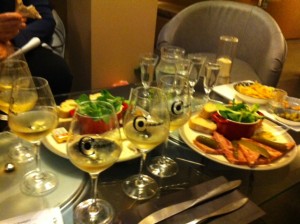Champagne is a beverage many of us will happily go out of our way to sample.
Yesterday, we went about 100 miles east, to Epernay, one of the capitals of the Champagne wine region, to taste some of the local bubbly and admire a tidy little town built by the manufacture of sparkling wine.
Going to Epernay from Paris is not difficult. A person could rent a car and drive there, but it is difficult to escape the metro Paris area, and someone who hasn’t been tasting will need to drive.
We chose the train, instead, leaving from the Gare de l’Est, (which always makes me think of French soldiers heading for the German frontier) an easy one-stop ride of about 90 minutes.
And, really, riding a train in Europe always is something of a romantic/pleasant/calming experience.
The train station in Epernay is near the edge of town, very close to the River Marne, which was such a significant geographical barrier during the First World War.
A short walk gets you to the main business street of the city, Rue Gambetta, and we dropped in at the C-Comme, a Champagne bar, where we knew we could taste a variety of bubbly while having lunch.
(Very few of the Champagne-makers in Epernay offer tours; one must go to the larger city of Reims. Plus, C-Comme specializes in small vintners who may not be known in Paris but can make some great Champagne.)
The madame of the salon gave us three samples before lunch, and we tasted them studiously, with palette-cleansing peanuts and olives between each one.
As is so often the case, how a person reacts to a wine is a function of time and food. At first, we thought we liked the second option best, but after the slightest bit of food, we shifted to the third choice — a fruity but dry and crisp Lagille & Fils bubbly made completely from Pinot Meunier grapes. It held our interest even after we were gone.
After three snacking plates (top of post) — of local ham (with sweet pickles), three cheeses and a mushroom/pork pate with toast — we were poured three more Champagnes to test, and they were fine, but we were three-for-three that No. 3 from the first flight was the best.
We would have bought some, but we had a long, leisurely walk ahead of us.
Just south of the business district is the Avenue de Champagne, a lengthy street of stately buildings, apparently from the 19th century, many of them houses for Champagne-producers. The first on the right is Moet-Chandon; the second is Perrier-Jouet.
We stopped at the local park outside what is now the hotel de ville, or city hall, to admire the greenery on a mild, almost sunny day, and the brilliant leaves of trees-in-autumn. There also was the traditional war monument (to the many sons of Epernay who did not survive the First World War).
We walked slowly a mile up the Avenue de Champagne and, on the other side of a roundabout, we reached our goal, the Mercier house, a producer known for its tours.
We had been there once before, many years ago, and were struck by their commitment to inviting in the consumers, as well as their social hall (sometimes used for weddings) some 30 meters beneath the chalky hills of the region.
The Bacchus Room, as it is known, is the one social bit of a vast underground world including 10-plus kilometers of fermentation galleries. Champagne must be kept out of the light, and at a constant 10 degrees Celsius, for a couple of years before it can be further processed and sold.
Visitors can choose the level of tasting they would like, for escalating prices, and we decided one glass was the best plan after tasting six glasses not long before.
Ahead of the tour, Mercier provides a listening device, in multiple languages, with information on the company’s history. The main event is a choppy Lumiere movie, made more than 100 years ago, showing how Mercier employees went through the business of making Champagne.
Then comes a trip down a slow elevator and into the depths of the plant, and a ride on a little train with narration of what you are seeing — which mostly is thousands of racks of bottles on their way to becoming Champagne.
The Mercier Champagne we had, after returning to the surface, was fairly ordinary, but perhaps we had been ruined by the bottle back at lunch time. The people at the front desk called us a cab (cheap, out here in the provinces) and we took the next train back to Gare de l’Est.
It was a relaxing and informative trip, and included lots of countryside — with Champagne in the middle and Paris at the beginning and end. I certainly can recommend it.


0 responses so far ↓
There are no comments yet...Kick things off by filling out the form below.
Leave a Comment